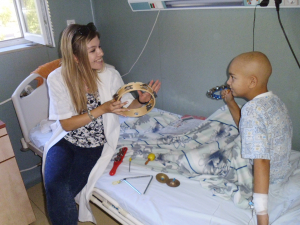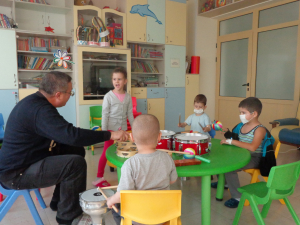
ARTON PROGRAM - The therapeutic power of the group
Creative projects involving group work - general musical performance or group painting, collage, sculpture - are useful in helping to explore and strengthen social...

Autism spectrum disorder is called a spectrum because autistic kids may have a wide range of symptoms, cognitive abilities, language skills and behaviors. This guide gives parents a comprehensive look at autism, from how its diversity can make it difficult to diagnose, to special issues affecting autistic kids, like picky eating and sensory issues, as well as different kinds of evidence-based interventions.
Autism spectrum disorder (ASD) is a neurodevelopmental disorder, which means that it impacts how a child develops. Autism begins in utero, although children with ASD might not be diagnosed until they are preschool- or even school-aged (or older), when signs of the disorder become more apparent.
Children with ASD have a combination of two kinds of behaviors: deficits in communication and social skills, and the presence of restricted or repetitive behaviors. It’s called a spectrum because individuals with the disorder may have a wide range of symptoms, cognitive abilities, language skills and behaviors.
Criteria for autism spectrum disorder
Signs of a deficit in communication and social skills may include, but are not limited to, a combination of the following:
In younger kids (under 3 years)
In older children
Children with restricted or repetitive behaviors perform repetitive actions and rituals and can become fixated on minute details to the point of distraction. In addition, they may:
To meet the criteria for ASD, a child’s symptoms in these two areas must be present in early childhood, though they may not become fully clear until later, when social demands exceed limited capacities. Alternatively, they may be clear early on and then masked later by learned strategies.
These symptoms must also cause clinically significant impairment in social, occupational, academic or other important areas of functioning.
In addition to the two required criteria to meet the diagnosis, children with autism spectrum disorder often have sensory issues and varying cognitive and verbal abilities.
Sensory problems: Many children with autism are unusually sensitive to sounds, lights, textures or smells. They may be overwhelmed by too much sensory input, avoiding, fleeing or melting down over things like bright lights, loud noises or commotion. Alternatively, they may seek more sensory input, which they may try to get by bumping into things and excessively touching and smelling things.
Verbal ability: Some children with autism don’t talk at all. Others talk in a stilted tone, or in an exaggerated “sing-song” or high-pitched voice. Highly verbal children with autism may monopolize conversations while showing little capacity for reciprocity or understanding what the other person wants or feels.
Autistic children may also repeat certain phrases without appearing to understand their significance, or possess what experts call “non-functional knowledge”— information they can recite, but not use to solve problems or carry on a conversation.
Children on the spectrum can also have medical problems and other mental health disorders, including anxiety, ADHD and depression, with symptoms that can be confused with autism.
People use different language when talking about autism. Some prefer to say “a child with autism” because it emphasizes the child’s identity outside of their diagnosis. This is commonly called “person-first” language and is often recommended as a respectful way to talk about disabilities and other health issues.
However, other people, including many autism activists, prefer to use the term “autistic.”
This is known as “identity-first” language. Autistic self-advocates assert that being autistic is in fact part of who they are — just like other labels like Catholic, African-American, gifted, and so on. They argue that saying “with autism” implies that autism is a negative thing that has happened to a person, rather than an integral part of their identity.
In this guide we use both “autistic” and “with autism” to acknowledge the diversity of people’s opinions.
Some people also refer to their child having “Asperger’s disorder.” That diagnosis is technically outdated, because in 2013 the Diagnostic and Statistical Manual of Mental Disorders (DSM-5) combined Asperger’s disorder into autism spectrum disorder. However, many people do continue to use the term Asperger’s to describe autistic children who are typically without language or intellectual impairment.
The diversity of autism spectrum disorder can make it difficult to correctly diagnose. Sometimes children with ASD are mistakenly diagnosed with a different disorder, like attention-deficit hyperactivity disorder (ADHD) or oppositional defiant disorder (ODD), or they are told that nothing is wrong. Other times kids are diagnosed with autism when they actually aren’t on the spectrum.
First Steps: There are a variety of screeners that pediatricians or other practitioners might employ as a first step to learning if a child might have autism, before beginning a formal evaluation. Some are questionnaires that parents fill out and others are assessments done by clinicians.
If a screener indicates that a child may have autism spectrum disorder, the child should receive a comprehensive evaluation with someone trained in diagnosing autism. This evaluation should include assessment of a child’s behaviors in different settings and within the context of their overall development, and it should incorporate both clinician observation and parent/caregiver interviews.
Evaluations should also include information about other areas of a child’s functioning across contexts. Assessing a child’s cognitive, motor, language and adaptive functioning can provide information on the most appropriate treatments and the impact their symptoms are having on their overall functioning. This includes using measures like:
Even with these tools it is important to be working with a mental health professional who has experience diagnosing people on the autism spectrum.
For children on the autism spectrum, the earlier they receive specialized support, the better outcome they are likely to have. Such early intervention can start in toddlerhood. But children sometimes miss out on that crucial intervention for a variety of reasons.
In many cases kids initially receive a diagnosis of speech-language impairments, ADHD or sensory issues, and it’s not until the social and academic challenges of school increase— around the age of 5 or 6 — that the child receives an autism diagnosis.
It’s not that these other diagnoses are necessarily wrong. It is estimated that 30 to 40 percent of children on the autism spectrum do also have ADHD, and sensory challenges are so common in kids with autism they are considered a symptom of the disorder.
But all too often, once a diagnosis is reached, parents and clinicians stop looking carefully at symptoms that would also indicate an autism diagnosis, which would change the treatment significantly.
While these children are getting treatment for ADHD or sensory issues, they’re missing out on therapy that can have a much more important impact on their lives.
Why girls with autism are often overlooked
Boys are diagnosed with autism at more than four times the rate of girls. The disorder is more common in boys, but because girls often don’t fit the stereotyped image of someone with autism, many girls go undiagnosed and suffer as a result. Some reasons for the missed diagnosis include:
If your child has been newly diagnosed with autism, one thing that can be a challenge is telling your parents and extended family. Autism is something that more and more people are aware of, but there’s still a lot of misinformation. The problems your child is having may not be visible to everyone in your family. But you need the people you are close to as allies in helping your child, so getting them on your team is important.
Focus on behaviors. Using behaviors others might have noticed — such as lack of eye contact, frequent meltdowns or inability to connect with other kids — is one way to start explaining what autism is, and why your child was diagnosed.
Explain autism basics
Don’t overwhelm them with information but make sure to tell them that:
It’s not unusual for medical problems to be overlooked in kids with autism, especially those who are nonverbal. When evaluating your child’s behaviors, it’s crucial to consider that some may actually be reactions to pain or discomfort from treatable medical or dental conditions that may have gone unrecognized. Kids with ASD may not be able identify or articulate the source of the pain or discomfort they are experiencing effectively.
Here are some commonly misinterpreted behaviors that may have medical causes:
If you notice any of these behaviors in your child, visiting your physician is a good idea to identify or rule out different medical problems, including:
Sensory issues are often first recognized during the toddler years, when parents notice that a child has an unusual aversion to noise, light, shoes that are deemed too tight and clothes that are irritating. They may also notice clumsiness and trouble climbing stairs, and difficulty with fine motor skills like wielding a pencil and fastening buttons. More baffling — and alarming — to parents are children who exhibit extreme behaviors, such as:
These and other atypical behaviors may reflect sensory issues — difficulty integrating information from the senses. Children with sensory issues may be overwhelmed by too much sensory input (i.e., hyper-sensitivity), or receive too little (i.e., hypo-sensitivity), which causes them to bump into and rub against things, in order to feel more. Sensory problems are now considered a symptom of autism because the majority of children and adults on the spectrum also have sensory issues.
When the brain struggles to deal with sensory input like sound, light and smell, kids can become overwhelmed and may have a tendency to flee to a more calming environment, become aggressive, or experience a severe meltdown.
In the majority of cases, sensory issues become significantly milder and less interfering as kids get older. Skills learned in occupational therapy and environmental accommodations can help limit the impact of sensory issues as kids get older.
Children on the autism spectrum are often very picky eaters. When mealtime issues arise, your first stop should be a pediatric gastroenterologist who has experience with kids on the spectrum, to make sure there are no medical issues. Other sources of mealtime problems include:
Sensory issues: Autistic kids often express a strong preference for foods that feel a certain way in their mouths. Some prefer soft or creamy foods like yogurt, soup or ice cream; others need the stimulation that crunchy foods like Cheetos or — if a parent is lucky, carrots — provide. In either case, that can put significant limitations on the different foods kids are willing to eat.
Underdeveloped oral motor musculature: Kids who eat almost exclusively soft foods may actually lack the muscle development that it takes to chew foods like steak or hamburger. Parents who don’t know this is the cause of their child’s distress will respond by allowing them to forgo the foods that would strengthen those muscles, so it becomes a vicious cycle.
Time and behavior at the table: Lots of parents experience the frustration of trying to get their children to sit at the table long enough to finish a meal. But with autistic kids the challenge can be magnified. And there is also the issue of safety. Unsafe behaviors might include throwing utensils or repeatedly getting up and running from the table.
For children and families who are struggling with an autistic child’s rigid eating habits, consulting a feeding specialist —this could be a child psychologist, speech-language pathologist or occupational therapist — can be helpful.
The tendency of children on the spectrum to wander off impulsively is a huge safety issue. Wandering off without warning — also known as elopement or bolting — can have tragic results, as children attracted to water have drowned. The behavior is in part attributed to an impaired sense of danger, which might inhibit a neurotypical child from leaving caregivers. Other explanations for bolting range from goal-directed (heading to a favorite place, pursuing something of interest) to escaping a stressor (an anxious situation or uncomfortable sensory stimuli).
Repetitive movements associated with autism are sometimes called stimming. The word stim is short for self-stimulation. It means repetitive movements that don’t appear to be purposeful, including hand flapping, rocking, blinking, pacing and repeating noises or words.
Among the criteria for an ASD diagnosis is “stereotyped or repetitive motor movements, use of objects or speech.” Some children engage in these repetitive movements to either block or increase sensory input, or as a means of alleviating distress. Children on the spectrum may stim both when they’re excited and when they’re frustrated or angry.
But these movements are only problematic if they interfere with a child’s functioning, including social interaction, daily activities and learning. Families worried about them are encouraged not to try to eradicate or draw undue attention to them, but instead to help children build communication skills and activities that may reduce time spent stimming.
Transitions are particularly challenging for kids with autism, and their reactions can be extreme. They may feel the need for sameness and routine is a way of adapting to a world that can be overwhelming and confusing. Deviation from the routine can feel very uncomfortable, even distressing, and they may refuse to transition, or engage in disruptive behavior such as having a tantrum.
Maintaining structured routines may help children with autism, especially for everyday transitions that are challenging, like bedtime or school mornings. It may also be helpful to provide children visual schedules of their routines as well as provide warnings (countdowns to the next activity) before upcoming transitions. It’s important to note that these general strategies, while helpful, may not be sufficient for all children with autism.
Rewarding kids when they handle a transition particularly well can also be an effective strategy. A reward could be as simple as labeled praise (for example, saying, “I really like how you stopped playing on the iPad when I told you it was time to get dressed. Good job!” Children can also be motivated by rewards like stickers or points that work up to bigger rewards, like more screen time or a favorite food. Access to a child’s special interests can also be a reward.
Behavioral treatments have been created to help children on the spectrum build skills they don’t develop automatically and reduce behaviors that are interfering with learning and communication. Several common types of treatment are described here:
Applied Behavior Analysis:
What it is: Applied behavior analysis (ABA) has been shown to help autistic children develop needed skills and minimize undesired behaviors such as self-injury, and it has been shown to be successful for kids all across the autism spectrum. Its effectiveness is backed up by hundreds of studies.
How it works: ABA is an evidence-based behavioral therapy that can take many forms, but they are all based on the same simple concept: reinforced behaviors will increase; behaviors that are not reinforced will reduce and eventually disappear.
Types of ABA:
Functional Communication Training:
What it is: FCT involves teaching an individual a reliable way of expressing their wants and needs with language, signs or images. It’s called “functional” because it doesn’t just teach kids to label an item (such as associating the word RED to a picture of an apple) but focuses on using words or signs to get something needed or desired — a food, a toy, an activity, a trip to the bathroom, a break from something. FCT uses positive reinforcement to teach children to communicate effectively with others to get their needs met and reduce problematic behavior.
How it works: Initially the therapist prompts the child to use the word, sign or picture and obtain the reward. This supported communication is repeated, each time resulting in the earned reward, until the child is able to succeed with less and less prompting from the therapist. Once kids are reliably using the functional communication for that item when the item is present, the next step is for them to “generalize,” or use it outside the specific situation in which it’s been taught, such as communicating with people other than the therapist.
The Verbal Behavior Approach (VB):
What it is: The verbal behavior approach, based on ABA, emphasizes teaching children language and other skills in a child-centered learning environment.
How it works: Therapists using a VB approach teach children language in a way that links language to its different purposes or functions. Initially, therapists using a VB approach focus on pairing the learning environment with activities and items that a child enjoys so that the learning environment is somewhere the child wants to be. This might involve the therapist giving a child fun toys or snacks for free. The therapist then teaches children to request (what VB therapists call, to mand) for these things. Once children are independently requesting things they want, the therapist gradually begins teaching other language and skill goals (such as labeling and responding to questions). The VB approach is used with children who communicate with spoken language as well as children who communicate in other ways, such as sign language. Books like The Verbal Behavior Approach: How to Teach Children With Autism and Related Disorders provide more information about this teaching approach.
Parent Training for Disruptive Behaviors in Autism Spectrum Disorder:
What it is: This evidence-based treatment, from the RUBI Autism Network, is based on the principles of ABA. It addresses challenging behaviors in youth with ASD, including noncompliance, aggression, temper outbursts and difficulties with transitions.
How it works: The therapist works closely with the parent to teach techniques (such as prevention strategies, daily schedules, reinforcement, compliance training, functional communication training) to reduce their child’s challenging behaviors and to encourage more appropriate behaviors.
Program for the Education and Enrichment of Relational Skills (PEERS®)
What it is: PEERS® is an evidence-based social skills intervention for youth with social challenges.
How it works: The intervention is delivered in a group format (parent and youth groups) to teach practical social skills, such as how to start and end conversations, select appropriate friends, handle teasing and bullying, handle arguments with peers, and show good sportsmanship.
Facing Your Fears (FYF):
What it is: Facing Your Fears is a group-based cognitive behavioral treatment designed to help youth with ASD who also have anxiety symptoms.
How it works: Facing Your Fears helps children learn to identify their worries and develop healthy coping strategies they can rely on when they are feeling anxious. Children are also given the opportunity to practice these new strategies inside their group. In addition to the child group, there is a separate group for parents to learn how to help support their child with ASD and co-occurring anxiety.
Occupational Therapy:
What it is: Occupational therapy, known as OT, is designed to help children acquire the skills needed to perform the activities—or “occupations”—of daily life.
How it works: Occupational therapists work with children to develop a variety of skills or abilities. This may include fine and gross motor skills, help with feeding issues or sensory issues, or developing essential self-help skills, like brushing teeth, dressing, toilet training, and more.
There is no medication for the symptoms of autism. But children on the spectrum may take medication that is aimed at curbing aggression or other problematic or dangerous behavior. And kids on the spectrum may take medication for other disorders that they may have, including anxiety, depression or ADHD. Any doctor prescribing medication should do so carefully, but this is particularly important for children who may have multiple diagnoses.
Medication for behavior problems
Risperdal is a medication that’s widely used to treat children who are aggressive or excessively irritable. Risperdal can successfully calm down kids with severe behavior problems, enabling them to function in school and within their families. The FDA has approved it for that use. Without it, some children would require residential treatment.
It’s important to know that Risperdal has side effects that include substantial weight gain and metabolic, neurological and hormonal changes that can be harmful. Without effective monitoring by a professional, some children experience irreversible damage. Some experts are concerned that children are being treated with this medication in lieu of other treatment — including behavioral treatment — that could be effective without the risk of these side effects.
Medication for co-occurring ADHD
Most children with ADHD are prescribed stimulant medications. Different children metabolize medication in different ways, so finding the right type of stimulant and dosage for your child may take several weeks. Other children may be prescribed non-stimulant medication if they are not responding to stimulants or experience troubling side-effects even after careful adjustment of dosage or type of stimulant.
Medication for co-occurring depression
Medications most often prescribed to treat depression are selective serotonin reuptake inhibitors, or SSRIs, which are also known as antidepressants. Clinicians may also prescribe an atypical antidepressant.
People struggling with depression can also benefit from therapy for depression, such as cognitive behavior therapy, dialectical behavior therapy or mindfulness.
Medication for co-occurring anxiety
The medications most often prescribed to treat anxiety are selective serotonin reuptake inhibitors, or SSRIs. Benzodiazepines are also sometimes prescribed for kids who are extremely anxious, but people can develop a tolerance for them so they should be prescribed carefully.
Behavior therapy such as cognitive behavior therapy (CBT) is considered to be the best treatment for anxiety. Facing Your Fears is a kind of CBT developed for children with autism. Medication may be prescribed in addition to therapy or to make very anxious kids more open to therapy.

Creative projects involving group work - general musical performance or group painting, collage, sculpture - are useful in helping to explore and strengthen social...

In the ARTON Program our team of oncopsychologists, art therapists and music therapists develops the process of children's creativity as a process of...

In ARTON sessions, creating a piece of music or a song is an emotional experience of coping and satisfaction for the participating children. They make friends with...

Painting provides patients with a spontaneous, plastic method of depicting thoughts and experiences. Painting with paints is not as structured as with pencil or...










